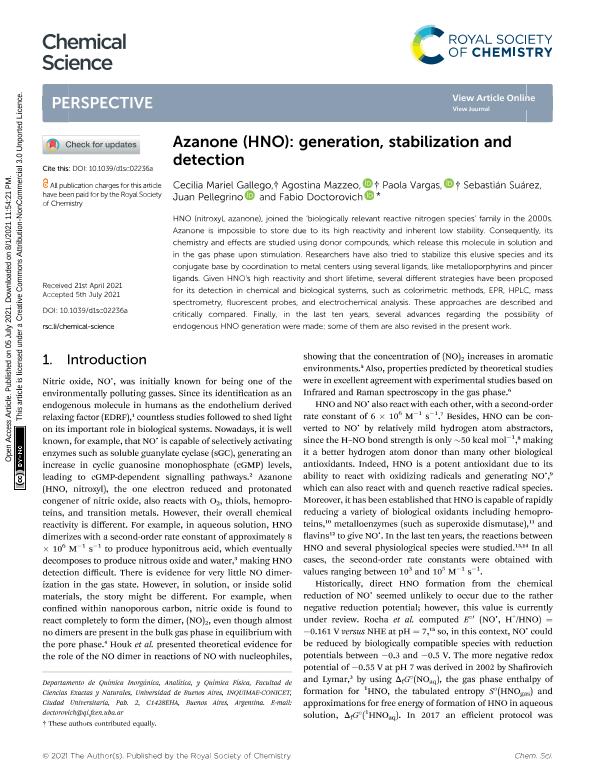Artículo
Azanone (HNO): Generation, stabilization and detection
Gallego, Cecilia Mariel ; Mazzeo, Agostina María
; Mazzeo, Agostina María ; Vargas, Paola; Suarez, Sebastian
; Vargas, Paola; Suarez, Sebastian ; Pellegrino, Juan
; Pellegrino, Juan ; Doctorovich, Fabio
; Doctorovich, Fabio
 ; Mazzeo, Agostina María
; Mazzeo, Agostina María ; Vargas, Paola; Suarez, Sebastian
; Vargas, Paola; Suarez, Sebastian ; Pellegrino, Juan
; Pellegrino, Juan ; Doctorovich, Fabio
; Doctorovich, Fabio
Fecha de publicación:
08/2021
Editorial:
Royal Society of Chemistry
Revista:
Chemical Science
ISSN:
2041-6520
e-ISSN:
2041-6539
Idioma:
Inglés
Tipo de recurso:
Artículo publicado
Clasificación temática:
Resumen
HNO (nitroxyl, azanone), joined the ‘biologically relevant reactive nitrogen species’ family in the 2000s. Azanone is impossible to store due to its high reactivity and inherent low stability. Consequently, its chemistry and effects are studied using donor compounds, which release this molecule in solution and in the gas phase upon stimulation. Researchers have also tried to stabilize this elusive species and its conjugate base by coordination to metal centers using several ligands, like metalloporphyrins and pincer ligands. Given HNO's high reactivity and short lifetime, several different strategies have been proposed for its detection in chemical and biological systems, such as colorimetric methods, EPR, HPLC, mass spectrometry, fluorescent probes, and electrochemical analysis. These approaches are described and critically compared. Finally, in the last ten years, several advances regarding the possibility of endogenous HNO generation were made; some of them are also revised in the present work.
Palabras clave:
HNO COORDINATION CHEMISTRY
,
HNO GENERATION
,
HNO DETECTION
Archivos asociados
Licencia
Identificadores
Colecciones
Articulos(INQUIMAE)
Articulos de INST.D/QUIM FIS D/L MATERIALES MEDIOAMB Y ENERGIA
Articulos de INST.D/QUIM FIS D/L MATERIALES MEDIOAMB Y ENERGIA
Citación
Gallego, Cecilia Mariel; Mazzeo, Agostina María; Vargas, Paola; Suarez, Sebastian; Pellegrino, Juan; et al.; Azanone (HNO): Generation, stabilization and detection; Royal Society of Chemistry; Chemical Science; 12; 31; 8-2021; 10410-10425
Compartir
Altmétricas



